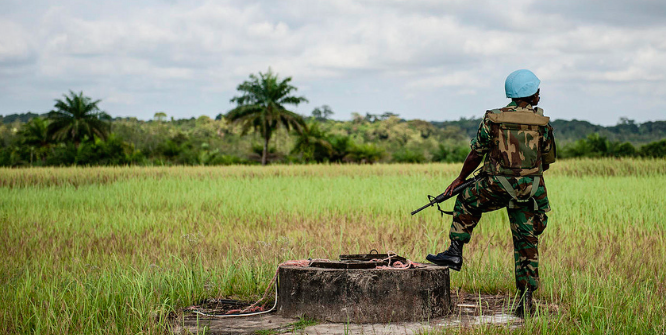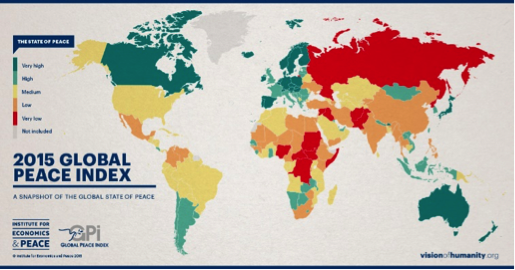The 2015 Global Peace Index

The 2015 Global Peace Index has been released today and shows that overall, global peace levels remained stable in 2014, but are lower than 2008. However the overall score disguises an increasing division between the most and least peaceful nations.
Since last year, four out of the nine geographical regions experienced an improvement in peace: Europe, North America, sub-Saharan Africa and Central America and the Caribbean. The other five regions became less peaceful. The most substantial changes in the Index, unsurprisingly, occurred in the Middle East and North Africa (MENA)—where several countries suffered from an upsurge in violence related to sectarian strife and civil conflicts resulting in the region being ranked as the least peaceful in the world.
This is the ninth edition of the Global Peace Index (GPI), which ranks the nations of the world according to their level of peacefulness. The index is composed of 23 qualitative and quantitative indicators from highly respected sources and ranks 162 independent states, covering 99.6 per cent of the world’s population. The index gauges global peace using three broad themes: the level of safety and security in society; the extent of domestic and international conflict; and the degree of militarisation. It is produced by the Sydney-based Institute for Economics and Peace, a non-partisan, non-profit research organisation seeking to better understand the interaction between peace, the economy and human development.
2015 Results
The societal safety and security domain improved slightly, driven by falls in the homicide rate and the likelihood of violent demonstrations. The improvements in homicide rates mainly reflected data updates in some high homicide countries. This improvement was counterbalanced by deteriorations in the ongoing conflict and militarisation domains, owing to increases in deaths from internal conflict, non-payment of UN peacekeeping dues, and a continuing deterioration in the impact of terrorism indicator.
Iceland is the most peaceful country, with the ten highest ranking nations in the GPI all being stable democracies. Nordic and Alpine countries are particularly well represented. Asia-Pacific is also represented at the top, with New Zealand ranked 4th, Japan at 8th and Australia at 9th.
MENA now ranks as the most violent region, overtaking South Asia from last year’s GPI. Yet again, Europe maintained its position as the most peaceful region in the world, supported by a lack of domestic and external conflicts. It was also the region that experienced the largest improvement in its score compared with 2014, continuing its eight-year trend of improving peacefulness.
It is important to note that peace is becoming more unevenly distributed. While Europe continued its long-term trend of improvement, the Middle East continued its recent trend of deterioration, further increasing the distance between the most and least peaceful regions and countries. In Europe and in many other developed countries, homicide rates and other forms of interpersonal violence continue to drop and are at historic lows. In 2008, there were only three countries that had a score worse than 3 out of 5: Somalia, Iraq and Sudan. However, by 2015 this increased to nine countries: Syria, Iraq, Afghanistan, South Sudan, Central African Republic, Somalia, Sudan, DRC and Pakistan, highlighting the further deterioration amongst the least peaceful countries in the world.
This year Guinea-Bissau had the largest improvement in peace, resulting in a rise of 24 places in the rankings to 120th. The next four largest improvements occurred in Cote d’Ivoire, Egypt, Tajikistan and Benin. A common theme among the largest improvers was a fall in the level of organised conflict, which occurred in all of the four aforementioned African nations.
Cancelling out its strong improvement in the 2014 edition of the GPI, Libya experienced the largest deterioration this year. Its score deteriorated substantially and consequently it fell 13 places down to 149th to become the 14th least peaceful country. Unsurprisingly the second biggest decline was recorded for the Ukraine, due to the conflict between Russian separatists and the Ukrainian government as well as the instability caused by Russia’s annexation of Crimea. Other countries that substantially deteriorated were Djibouti and Niger which fell 42 and 28 places, respectively.
In addition to presenting the findings from the 2015 GPI and its eight-year trend analysis, this year’s report provides an updated methodology to account for the economic impact of violence on the global economy. The report also contains a new analysis on Positive Peace and describes its relationship to development and other significant and positive societal outcomes. A detailed thematic analysis of the three aforementioned domains of the GPI is also included.
Click here to read the report or use the interactive map to compare countries in the index.
Camilla Schippa is the Director of the Institute for Economics and Peace. This article can be republished with attribution under a Creative Commons Licence.



